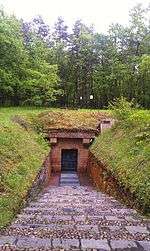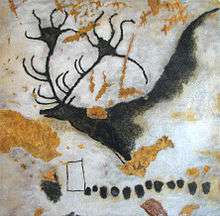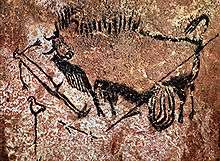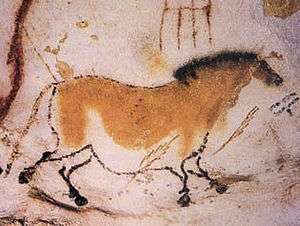Lascaux
| Lascaux | |
|---|---|
| Name as inscribed on the World Heritage List | |
| Location | near Dordogne |
| Type | Cultural |
| Reference | 85 |
| Inscription history | |
| Inscription | 1979 (3rd Session) |

Lascaux (Lascaux Caves) (English /læsˈkoʊ/,[1] French: [lasko][2]) is the setting of a complex of caves in southwestern France famous for its Paleolithic cave paintings. The original caves are located near the village of Montignac, in the department of Dordogne. They contain some of the best-known Upper Paleolithic art. These paintings are estimated to be circa 17,300 years old. They primarily consist of images of large animals, most of which are known from fossil evidence to have lived in the area at the time. In 1979, Lascaux was added to the UNESCO World Heritage Sites list along with other prehistoric sites in the Vézère valley.[3]
History since rediscovery

On September 12, 1940, the entrance to Lascaux Cave was discovered by 18-year-old Marcel Ravidat. Ravidat returned to the scene with three friends, Jacques Marsal, Georges Agnel, and Simon Coencas, and entered the cave via a long shaft. The teenagers discovered that the cave walls were covered with depictions of animals.[4][5] The cave complex was opened to the public in 1948.[6] By 1955, the carbon dioxide, heat, humidity, and other contaminants produced by 1,200 visitors per day had visibly damaged the paintings and introduced lichen on the walls. The cave was closed to the public in 1963 to preserve the art. After the cave was closed, the paintings were restored to their original state and were monitored daily. Rooms in the cave include the Hall of the Bulls, the Passageway, the Shaft, the Nave, the Apse, and the Chamber of Felines.
Lascaux II, a replica of the Great Hall of the Bulls and the Painted Gallery located 200 meters away from the original, was opened in 1983, so that visitors may view the painted scenes without harming the originals.[5] Reproductions of other Lascaux artwork can be seen at the Centre of Prehistoric Art at Le Thot, France.
Since 1998, the cave has been beset with a fungus, variously blamed on a new air conditioning system that was installed in the caves, the use of high-powered lights and the presence of too many visitors.[7] As of 2008, the cave contained black mold which scientists were and still are trying to keep away from the paintings. In January 2008, authorities closed the cave for three months even to scientists and preservationists. A single individual was allowed to enter the cave for 20 minutes once a week to monitor climatic conditions. Now only a few scientific experts are allowed to work inside the cave and just for a few days a month but the efforts to remove the mold have taken a toll, leaving dark patches and damaging the pigments on the walls.[8]
Geographic setting

In its sedimentary composition, the Vézère drainage basin covers one fourth of the département of the Dordogne, the northernmost region of the Black Périgord. Before joining the Dordogne River near Limeuil, the Vézère flows in a south-westerly direction. At its centre point, the river's course is marked by a series of meanders flanked by high limestone cliffs that determine the landscape. Upstream from this steep-sloped relief, near Montignac and in the vicinity of Lascaux, the contours of the land soften considerably; the valley floor widens, and the banks of the river lose their steepness.
The Lascaux valley is located some distance from the major concentrations of decorated caves and inhabited sites, most of which were discovered further downstream. In the environs of the village of Eyzies-de-Tayac Sireuil, there are no less than 37 decorated caves and shelters, as well as an even greater number of habitation sites from the Upper Paleolithic, located in the open, beneath a sheltering overhang, or at the entrance to one of the area's karst cavities. This is the highest concentration in western Europe.
The images

The cave contains nearly 2,000 figures, which can be grouped into three main categories: animals, human figures, and abstract signs. The paintings contain no images of the surrounding landscape or the vegetation of the time.[9] Most of the major images have been painted onto the walls using red, yellow, and black colours from a complex multiplicity of mineral pigments[10]:110[11] including iron compounds such as iron oxide (ochre)[12]:204 haematite, and goethite,[11][13] as well as manganese-containing pigments.[11][12]:208 Charcoal may also have been used[12]:199 but seemingly to a sparing extent.[10] On some of the cave walls, the colour may have been applied as a suspension of pigment in either animal fat or calcium-rich cave groundwater or clay, making paint,[10] that was swabbed or blotted on, rather than applied by brush.[13] In other areas, the colour was applied by spraying the pigments by blowing the mixture through a tube.[13] Where the rock surface is softer, some designs have been incised into the stone. Many images are too faint to discern, and others have deteriorated entirely.
Over 900 can be identified as animals, and 605 of these have been precisely identified. Out of these images, there are 364 paintings of equines as well as 90 paintings of stags. Also represented are cattle and bison, each representing 4 to 5% of the images. A smattering of other images include seven felines, a bird, a bear, a rhinoceros, and a human. There are no images of reindeer, even though that was the principal source of food for the artists.[14] Geometric images have also been found on the walls.
The most famous section of the cave is The Hall of the Bulls where bulls, equines, and stags are depicted. The four black bulls, or aurochs, are the dominant figures among the 36 animals represented here. One of the bulls is 5.2 metres (17 ft) long, the largest animal discovered so far in cave art. Additionally, the bulls appear to be in motion.[14]
A painting referred to as "The Crossed Bison", found in the chamber called the Nave, is often submitted as an example of the skill of the Paleolithic cave painters. The crossed hind legs create the illusion that one bison is closer to the viewer than the other. This visual depth in the scene demonstrates a primitive form of perspective which was particularly advanced for the time.
Interpretation of images
Some anthropologists and art historians also theorize that the paintings could be an account of past hunting success, or could represent a mystical ritual in order to improve future hunting endeavors. This latter theory is supported by the overlapping images of one group of animals in the same cave-location as another group of animals, suggesting that one area of the cave was more successful for predicting a plentiful hunting excursion.
Applying the iconographic method of analysis to the Lascaux paintings (studying position, direction and size of the figures; organization of the composition; painting technique; distribution of the color planes; research of the image center), Thérèse Guiot-Houdart attempted to comprehend the symbolic function of the animals, to identify the theme of each image and finally to reconstitute the canvas of the myth illustrated on the rock walls.[15]
Julien d'Huy and Jean-Loïc Le Quellec showed that certain angular or barbed signs of Lascaux may be analysed as "weapon" or "wounds". These signs affect dangerous animals—big cats, aurochs and bison—more than others and may be explained by a fear of the animation of the image.[16] Another finding supports the hypothesis of half-alive images. At Lascaux, bison, aurochs and ibex are not represented side by side. Conversely, one can note a bison-horses-lions system and an aurochs-horses-deer-bears system, these animals being frequently associated.[17] Such a distribution may show the relationship between the species pictured and their environmental conditions. Aurochs and bison fight one against the other, and horses and deer are very social with other animals. Bison and lions live in open plains areas; aurochs, deer and bears are associated with forests and marshes; ibex habitat is rocky areas, and horses are highly adaptive for all these areas. The Lascaux paintings' disposition may be explained by a belief in the real life of the pictured species, wherein the artists tried to respect their real environmental conditions.[18]
Less known is the image area called the Abside (Apse), a roundish, semi-spherical chamber similar to an apse in a Romanesque basilica. It is approximately 4.5 meters in diameter (about 5 yards) and covered on every wall surface (including the ceiling) with thousands of entangled, overlapping, engraved drawings.[19] The ceiling of the Apse, which ranges from 1.6 to 2.7 meters high (about 5.2 to 8.9 feet) as measured from the original floor height, is so completely decorated with such engravings that it indicates that the prehistoric people who executed them first constructed a scaffold to do so.[9][20]

According to David Lewis-Williams and Jean Clottes who both studied presumably similar art of the San people of Southern Africa this type of art is spiritual in nature relating to visions experienced during ritualistic trance-dancing. These trance visions are a function of the human brain and so are independent of geographical location.[21] Nigel Spivey, a professor of classical art and archeology at the University of Cambridge, has further postulated in his series, How Art Made the World, that dot and lattice patterns overlapping the representational images of animals are very similar to hallucinations provoked by sensory-deprivation. He further postulates that the connections between culturally important animals and these hallucinations led to the invention of image-making, or the art of drawing.[22]
Threats

The opening of Lascaux Cave after World War II changed the cave environment. The exhalations of 1,200 visitors per day, presence of light, and changes in air circulation have created a number of problems. Lichens and crystals began to appear on the walls in the late 1950s, leading to closure of the caves in 1963. This led to restriction of access to the real caves to a few visitors every week, and the creation of a replica cave for visitors to Lascaux. In 2001, the authorities in charge of Lascaux changed the air conditioning system which resulted in regulation of the temperature and humidity. When the system had been established, an infestation of Fusarium solani, a white mold, began spreading rapidly across the cave ceiling and walls.[23] The mold is considered to have been present in the cave soil and exposed by the work of tradesmen, leading to the spread of the fungus which was treated with quicklime. In 2007, a new fungus, which has created grey and black blemishes, began spreading in the real cave.
Organized through the initiative of the French Ministry of Culture, an international symposium titled "Lascaux and Preservation Issues in Subterranean Environments" was held in Paris on February 26 and 27, 2009, under the chairmanship of Jean Clottes. It brought together nearly three hundred participants from seventeen countries with the goal of confronting research and interventions conducted in Lascaux Cave since 2001 with the experiences gained in other countries in the domain of preservation in subterranean environments.[24] The proceedings of this symposium were published in 2011. Seventy-four specialists in fields as varied as biology, biochemistry, botany, hydrology, climatology, geology, fluid mechanics, archaeology, anthropology, restoration and conservation, from numerous countries (France, United States, Portugal, Spain, Japan, and others) contributed to this publication.[25]
The problem is ongoing, as are efforts to control the microbial and fungal growths in the cave. The fungal infection crises have led to the establishment of an International Scientific Committee for Lascaux and to rethinking how, and how much, human access should be permitted in caves containing prehistoric art.[26]
See also
References
- ↑ "American English Dictionary: Definition of Lascaux". Collins. Retrieved 18 August 2013.
- ↑ "English Dictionary: Definition of Lascaux". Collins. Retrieved 18 August 2013.
- ↑ "Prehistoric Sites and Decorated Caves of the Vézère Valley". UNESCO World Heritage Center. Retrieved 30 December 2012.
- ↑ Thomas Jr., Robert McG. (March 31, 1995). "Marcel Ravidat is Dead at 72; Found Lascaux Paintings". The New York Times. Retrieved 30 December 2012.
- 1 2 Bahn, Paul G. (2007). Cave Art: A Guide to the Decorated Ice Age Caves of Europe. London: Frances Lincoln. pp. 81–85. ISBN 0711226555.
- ↑ Littlewood, Ian (2005). Justin Wintle, ed. The timeline history of France. New York: Barnes & Noble. p. 296. ISBN 0760779759.
- ↑ Lichfield, Paul (12 July 2008). "Six months to save Lascaux". The Independent. Retrieved 30 December 2012.
- ↑ Moore, Molly (July 1, 2008). "Debate Over Moldy Cave Art Is a Tale of Human Missteps". The Washington Post. Retrieved 30 December 2012.
- 1 2 Nechvatal, Joseph (2011). Immersion Into Noise. Ann Arbor: Open Humanities Press. pp. 74–76. ISBN 978-1-60785-241-4. Retrieved 30 December 2012.
- 1 2 3 Dickson, D. Bruce. The Dawn of Belief: Religion in the Upper Paleolithic of Southwestern Europe. ISBN 9780816513369.
- 1 2 3 Chalmin E, Farges F, Vignaud C, et al. Discovery of Unusual Minerals in Paleolithic Black Pigments from Lascaux (France) and Ekain (Spain).
- 1 2 3 Rapp, George R. (2013). Archaeomineralogy. ISBN 9783662050057.
- 1 2 3 Encyclopedia of Stone Age Art
- 1 2 Curtis, Gregory (2006). The Cave Painters: Probing the Mysteries of the World's First Artists (1st ed.). New York: Alfred A. Knopf. pp. 96–97, 102. ISBN 1400043484.
- ↑ Guiot-Houdart, Thérèse (2004). Lascaux et les mythes (in French). Périgueux: Pilote 24. ISBN 2-912347-39-4.
- ↑ Julien d'Huy et Jean-Loïc Le Quellec (2010). "Les animaux 'fléchés' à Lascaux: nouvelle proposition d’interprétation" Préhistoire du Sud-Ouest 18(2): 161-170
- ↑ Denis Tauxe (2007)."L’organisation symbolique du dispositif pariétal de la grotte de Lascaux", Préhistoire du Sud-Ouest, 15: 177-266
- ↑ Julien d'Huy (2011). "La distribution des animaux à Lascaux reflèterait leur distribution naturelle", Bulletin de la Société Historique et Archéologique du Périgord CXXXVIII, 493-502
- ↑ Leroi-Gourhan, André. The Art of Prehistoric Man in Western Europe. London: Thames and Hudson. 1968. p. 315
- ↑ Mario Ruspoli, The Cave of Lascaux: The Final Photographic Record (New York: Abrams, 1983) pp. 146-47
- ↑ Harry Francis Mallgrave (26 June 2013). Architecture and Embodiment: The Implications of the New Sciences and Humanities for Design. Routledge. pp. 190–. ISBN 978-1-135-09424-9.
- ↑ Gray, S. W. (2014). [vro.uow.edu.au/cgi/viewcontent.cgi?article=5404&context=theses "The cartographic paradigm in contemporary Australian landscape painting"] Check
|url=value (help). - ↑ Joëlle Dupont; Claire Jacquet; Bruno Dennetière; Sandrine Lacoste (2007). "Invasion of the French Paleolithic painted cave of Lascaux by members of the Fusarium solani species complex". Mycologia. 99 (4): 526–533. doi:10.3852/mycologia.99.4.526. PMID 18065003.
- ↑ At the Takamatsuzuka Tomb in Japan, and Altamira in Spain, for example.
- ↑ Coye, N. dir. (2011), Lascaux et la conservation en milieu souterrain: actes du symposium international (Paris, 26-27 fév. 2009) = Lascaux and Preservation Issues in Subterranean Environments: Proceedings of the International Symposium (Paris, February 26 and 27), Éditions de la Maison des sciences de l'homme, 360 p. In french and english.
- ↑ Simons, Marlise (9 December 2007). "Fungus Once Again Threatens French Cave Paintings". World:Europe. New York Times. Retrieved 15 October 2010.
Further reading
- Dubowski, Mark (2010). Discovery in the Cave (Children's early reader). New York, New York, USA: Random House. ISBN 0375858938
- Curtis, Gregory (2006). The Cave Painters: Probing the Mysteries of the World's First Artists. New York, New York, USA: Knopf. ISBN 1-4000-4348-4
- Lewis-Williams, David (2004). The Mind in the Cave: Consciousness and the Origins of Art. Thames and Hudson. ISBN 0-500-28465-2
- Bataille, Georges (2005). The Cradle of Humanity: Prehistoric Art and Culture. New York, New York: Zone Books. ISBN 1-890951-55-2
- Joseph Nechvatal, Immersive Excess in the Apse of Lascaux, Technonoetic Arts 3, no3. 2005
- B.et G. Delluc (dir.), Le Livre du Jubilé de Lascaux 1940-1990, Société historique et archéologique du Périgord, supplément au tome CXVII, 1990, 155 p., ill.
- B. et G. Delluc, 2003 : Lascaux retrouvé. Les recherches de l'abbé André Glory, Pilote 24 édition, 368 p., ill.
- B. et G. Delluc, 2006 : Discovering Lascaux, Sud Ouest, nouvelle édition entièrement revue et très augmentée, 80 p., ill. plans et coupe.
- B. et G. Delluc, 2008 : Dictionnaire de Lascaux, Sud Ouest, Bordeaux. Plus de 600 entrées et illustrations. Bibliographie (450 références). ISBN 978-2-87901-877-5.
- B. et G. Delluc, 2010 : Lascaux et la guerre. Une galerie de portraits, Bull. de la Soc. historique et arch. du Périgord, CXXXVI, 2e livraison, 40 p., ill., bibliographie.
- A. Glory, 2008 : Les recherches à Lascaux (1952-1963). Documents recueillis et présentés par B. et G. Delluc, XXXIXe suppl. à Gallia-Préhistoire, CNRS, Paris.
- Joseph Nechvatal, 2011: Immersion Into Noise, University of Michigan Library's Scholarly Publishing Office. Ann Arbor.
- Rigaud, Jean-Philippe (October 1988). "Art Treasures from the Ice Age: Lascaux Cave". National Geographic. Vol. 174 no. 4. pp. 482–499. ISSN 0027-9358. OCLC 643483454.
External links
| Wikimedia Commons has media related to Lascaux. |
- Lascaux Cave Official Lascaux Web site, from the French Ministry of Culture
- Save Lascaux Official website of the International Committee for the Preservation of Lascaux
- Lascaux Cave Art Symposium The Bradshaw Foundation
- Human Timeline (Interactive) – Smithsonian, National Museum of Natural History (August 2016).
Coordinates: 45°02′57″N 1°10′34″E / 45.04917°N 1.17611°E
